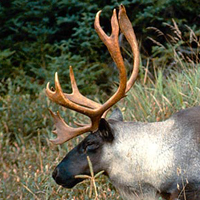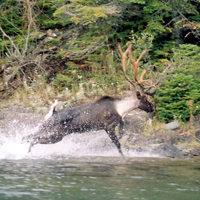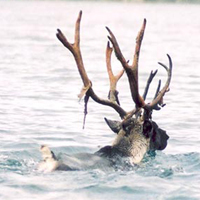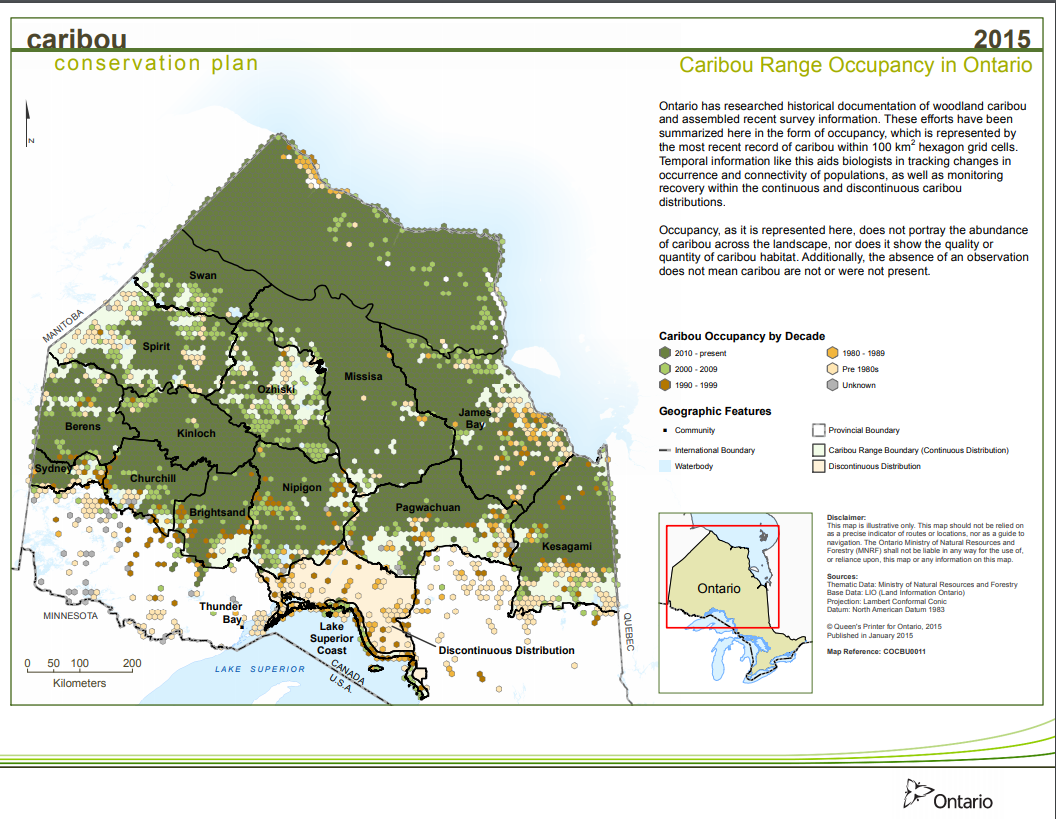Caribou (Boreal population)
Scientific name: Rangifer tarandus



Cover photos credit: Gerry Racey
Status
Threatened
“Threatened” means the species lives in the wild in Ontario, is not endangered, but is likely to become endangered if steps are not taken to address factors threatening it.
There are two distinct populations of caribou in Ontario: the Eastern Migratory population and the Boreal population. Both populations of caribou are listed as species at risk in Ontario.
Date added to the Species at Risk in Ontario List
The boreal population of caribou was already assessed as threatened when the Endangered Species Act took effect in 2008.
Read the Assessment Report (PDF)
What it looks like
Caribou are medium-sized members of the deer family. There are two distinct populations of caribou in Ontario. The boreal population of caribou lives in the boreal forest all year. The migratory population of caribou lives on the tundra during the spring and summer and moves into the boreal forest for the rest of the year. Both populations of caribou are listed as a species at risk in Ontario.
Caribou are well-adapted for life in boreal regions. They have thick coats to help them survive cold winters and large rounded hooves that let them dig for food and walk easily on snow and soft ground such as peat lands. Mature caribou usually weigh between 110 and 210 kilograms and reach a shoulder height of between one and 1.2 metres.
Where it lives
Caribou habitat in the boreal forest is constantly changing. Much of the forest is naturally in an unsuitable condition for caribou at any one time, but caribou need and use the entire landscape over time as habitat changes. Disturbances from fires, blowdown, and insects can quickly change the amount and distribution of habitat. There is also great ecological variation in caribou habitat across the province ranging from upland fire-dependent forests in the northwest to extensive lowland forests in the northeast where fire is much less frequent.
At the broad landscape scale, caribou require large, undisturbed areas of old or mature conifer upland forest and lowlands dominated by jack pine and/or black spruce. These areas allow caribou to effectively separate themselves from higher densities of moose, white-tailed deer, grey wolves and black bears which tend to be associated with younger mixed or deciduous forest. At smaller scales, caribou seasonally select specific habitat features and areas that support successful reproduction and calf rearing, provide summer and/or winter forage, and/or facilitate movement between discrete areas of use.
Where it’s been found in Ontario
The boreal population of caribou was formerly found throughout most of northern Ontario. Its range has now receded and the species is generally found north of Sioux Lookout, Geraldton and Cochrane with a few isolated populations further south along the shoreline and islands of Lake Superior. It is estimated that there are roughly 5,000 boreal population caribou in Ontario.
In the rest of Canada, boreal population caribou are found throughout the boreal forest from Newfoundland and Labrador to the Northwest Territories.
View a larger version of this map (PDF)
What threatens it
Threats to the boreal population of caribou include habitat loss, degradation and fragmentation due to human settlement and development activities such as forestry, mining, hydro corridors and roads. Caribou are also at risk from an increase in predation and disease that accompanies such broad habitat changes. Between 40 to 50 per cent of caribou range in Ontario has been lost since the late 1800s.
Climate change has the potential to affect the boreal population of caribou in the future by further reducing available habitat and influencing food sources. These changes could also create conditions that are more suitable for moose and deer and as a result increase the number of predators that these new species would attract.
Action we are taking
Threatened species and their general habitat are automatically protected.
Agreement for the Conservation of Caribou, Boreal Population in Ontario
Read the full document (April 21, 2022).
Read our progress report from Year 1
Read our progress report from Year 2
Habitat protection
General habitat protection - June 30, 2013
General habitat descriptions are technical, science-based documents that provide greater clarity on the area of habitat protected for a species.
Read the general habitat description (July 2, 2013).
Caribou Conservation Plan
Read the full document (October 13, 2009).
Recovery strategy
A recovery strategy advises the ministry on ways to ensure healthy numbers of the species return to Ontario.
Read the executive summary and full document (August 21, 2008).
Conservation and recovery
The Range Management Policy in Support of Woodland Caribou Conservation and Recovery describes the Range Management Approach and how the ministry will make coordinated planning decisions to maintain or improve range condition. Range condition provides us with an understanding of how caribou are doing within a broad geographical area.
As part of the Range Management Approach, Integrated Range Assessment Reports have been prepared for each range and documents range condition:
- Berens Range
- Brightsand Range
- Churchill Range
- Ranges in the Far North of Ontario
- Kesagami Range
- Nipigon Range
- Pagwachuan Range
- Sydney Range
State of the Woodland Caribou Resource Report
The State of the Woodland Caribou Resource Report meets the requirement under the Endangered Species Act to report on the progress towards the protection and recovery of a species 5 years after the publication of the government’s response statement. It also fulfills a policy commitment in Ontario’s Woodland Caribou Conservation Plan to develop a State of the Woodland Caribou Resource Report in 2014.
While this report is not a review or revision of the Caribou Conservation Plan, it highlights the actions taken on commitments made in the Caribou Conservation Plan and provides a thorough overview of initiatives undertaken towards the protection and recovery of caribou. The report is divided into three parts:
- State of the Woodland Caribou Resource Report (Part 1)
- State of the Woodland Caribou Resource Report (Part 2)
- State of the Woodland Caribou Resource Report (Part 3)
What you can do
Report a sighting
- Become involved, learn about recovery and conservation efforts, and report caribou sightings to your local Ministry of Natural Resources and Forestry office.
- The Ministry of Natural Resources tracks species at risk such as the caribou. You can use a handy online form to report your sightings to the Natural Heritage Information Centre. Photographs with specific locations or mapping coordinates are always helpful.
Be a good steward
- If you are camping or canoeing in caribou country, avoid setting up camp on islands or peninsulas that may serve as caribou calving sites. Such activities disturb this sensitive species and the smell of food may inadvertently attract predators to calving sites.
- The Ontario Species at Risk Stewardship Fund supports public involvement in species at risk protection and recovery activities, including those that help caribou.
Report illegal activity
- Report any natural resource related violations such as the killing or harming of any species at risk or their habitat to the Ministry of Natural Resources TIPS line at
1-877-TIP-SMNR (847-7667) .
Quick facts
- Caribou are excellent swimmers and their hollow hair makes them extremely buoyant. They often flee into the water to escape predators.
- Unlike moose and deer, female caribou have only one calf each year. They never have twins or triplets.
